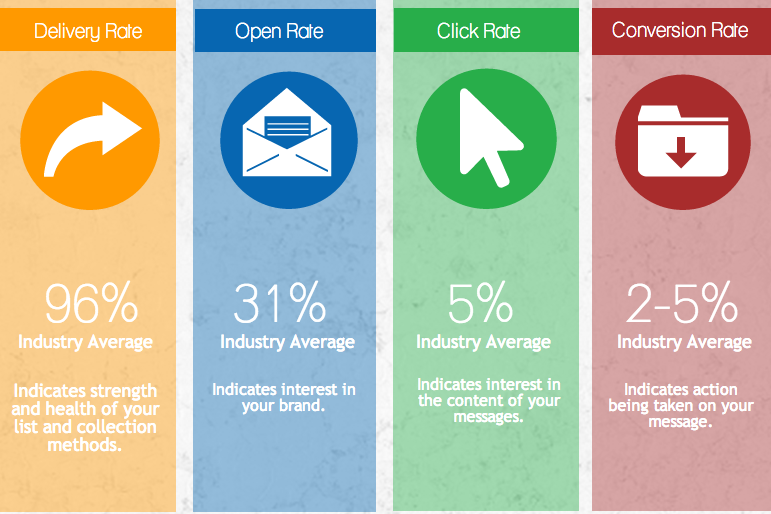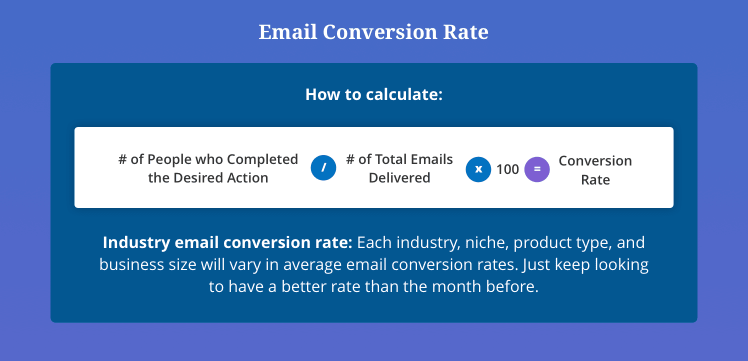7 Email Marketing Metrics For the Keen Marketer

Table of Contents
- What Are Metrics In Email Marketing?
- The Most Valuable Email Marketing Metrics and KPIs
- 7 Email Marketing Metrics Every Marketer Must Know
- Key Takeaways
- Conclusion
- FAQs
Any successful marketing strategy in the digital era makes sure to consider the vital element of email marketing. But email marketing is not as simple as it sounds. As a marketer, you should be aware of some essential email marketing metrics to make the most out of your email marketing campaign. This knowledge is important to make your email campaigns successful and optimize each email for increased engagement.
Like other aspects of a marketing campaign, metrics are bound to change now and then. While each email marketing campaign has different goals and each marketer looks up to different email marketing benchmarks, you must definitely know some email marketing metrics.

What Are Metrics In Email Marketing?
Email metrics, also known as KPIs (key performance indicators), are a way to measure the success of an email marketing campaign. It is important to have email marketing metrics to help you assess which elements of your strategy worked out well for your campaign and which didn’t. Email marketing metrics can help you effectively design more successful email marketing campaigns in the future with optimum resources. As a marketer, you should have the basic knowledge of measuring the results of your marketing effort over time.
Email marketing is crucial for small businesses now more than ever. And to ensure that your efforts are headed in the right direction, you need marketing metrics. Email marketing metrics demonstrate how well campaigns perform according to the KPIs you have chosen for a particular campaign.
Metrics help you decide what needs to be discontinued in future email campaigns. Metrics provide you with a number-based success score. You must rely on facts and figures more than mere intuition as a marketer. Some of the important benefits of using email marketing metrics are as follows:
- They help you tailor your communication to the interest of the recipients of your email messages.
- They track and record the success of different aspects of your email campaign.
- They also prevent you from paying more than what is required for the email services you are using.
- With the help of metrics, you can ensure that your emails do not end up in the recipient’s spam folder.

The Most Valuable Email Marketing Metrics and KPIs
There are several email marketing metrics that email marketers use, but you will have to choose a few specific ones that best suit the goals and nature of your email marketing campaign. Here is a list of some of the most valuable email marketing KPIs.
- Open rate
- Unique clicks
- Unique opens
- Click-through rate (CTR)
- Email bounce rate
- Conversion rate
- Return on investment (ROI)
- Revenue per subscriber
- Revenue per email
- Clicks by device
- Domain-based opens (Domain open rate)
- Domain click rate
- Opens by device
- Days and times
- List membership
- Forwards
- Shares
- Unsubscribe rate
- Spam complaints
- Spam score (also called spam percentage)
- List growth rate
- Engagement over time
7 Email Marketing Metrics Every Marketer Must Know
Let’s look at 7 email KPI metrics that you must know as a marketer.
1. Open rate
An open rate is a metric crucial to all email marketing campaigns, irrespective of its specific goals. It tells you how engaged your subscribers are by measuring how many recipients actually opened the email you sent versus the number of people you had sent the email to in the first place. An open rate is represented differently across different marketing platforms. It could be a number (e.g., 10 out of 100 people) or a percentage (e.g., 50 percent). And it shows you the bridge between your email subscribers and your actual revenue. With the help of the open rate, you can design more successful email campaigns in the future.
2. Click-through rate (CTR)
CTR or the click-through rate is a commonly used metric that helps you determine the performance of your email campaigns by measuring the number of people who clicked on the embedded links in your email. If you’ve included a link to an offer or a website, the CTR measures the number or percentage of subscribers who clicked on that link. This knowledge can help you craft better emails in the future.
CTRs are usually much lower than the open rates. But, they are crucial as they tell you whether or not your offers or the embedded links in the email were attractive or suitable enough to convey your message and get your recipients engaged.
3. Bounce rate
When you are working on an email campaign, it is also important that you track the bounce rate of your campaign. A bounce rate measures the number of email subscribers who didn’t receive your email at all. It might not be one of the email marketing KPIs that directly lets you analyze and assess the success of your campaign, but it informs you about the problem with email addresses.

Bounce rates are of two types – a soft bounce tells you about the temporary problems with email addresses, while a hard bounce hints at the permanent problems with these addresses. To get a clear idea of your subscriber list, you can measure the bounce rates against the open rates. A double-opt-in can help you decrease your bounce rates.
4. Number of unsubscribers
This is one of the simplest email marketing metrics in terms of measurement. You can find this metric in your main dashboard or the metrics dashboard. Email providers generally tell you the number of people who have unsubscribed.
You might get a little discouraged from seeing a high number of unsubscribers, but it is important to view unsubscribers as a method of fine-tuning your subscribers’ list. A clear opt-out or unsubscribe option is essentially required to let your subscribers exercise their choice.
5. Spam complaints
It is discouraging when your emails get marked as spam. You can either ignore such events or pay attention to them and use them to ensure that your future emails get delivered. If your spam complaint rate is too high, you should be aware that your email service provider can take action against you and might even block your account.
The email service provider itself tracks this number for you. If you are getting a high rate of spam complaints, make sure nothing is technically wrong with your emails. You can look out and trace a pattern and avoid tactics that you think might be responsible for your emails being flagged as spam.
6. Conversion rate
A conversion rate refers to the percentage of email recipients who end up taking some valuable action as a response to your email. It is a positive indicator of your email marketing campaign’s success. One of the most important email marketing metrics, a conversion rate depends on the nature of your industry and the goals of your campaign. It is a valuable action taken by your email subscribers.

It tells you how many people clicked the link in your email and then completed a specific action. It is an important insight into your ROI. Knowing how much you are spending on your campaign and how many subscribers you have been able to convert, you can determine if your investment is returning the desired output.
7. Mobile open rate
Also known as device open rate, mobile open rate works just like the regular open rate. The only difference is that the mobile open rate applies specifically to mobile devices. Mobile open rates are more popular and more likely to occur throughout the day and week than desktop open rates, which are more of a weekday phenomenon.
If more of your subscribers are opening your emails when on the desktop, it is worth noting that your emails are not well optimized for mobile devices. You should also pay attention to the fact that a certain operating system could also be affecting your mobile open rates.
Key Takeaways
- Email metrics, also known as KPIs (key performance indicators), are a way to measure the success of an email marketing campaign.
- Some of the most valuable email marketing metrics and KPIs include forwards, shares, open rate, conversion rate, CTR, ROI, spam complaints, unsubscribe rate, spam score, list growth rate, engagement over time, domain click rate, domain open rate, etc.
- Open rate tells you how many recipients actually opened the email sent by you. It compares it with the number of people you had sent the email to in the first place.
- CTR is a commonly used metric. It measures the number of people who clicked on the embedded links in your email.
- A bounce rate measures the number of email subscribers who didn’t receive your email at all.
- If you are getting a high rate of spam complaints, make sure nothing is technically wrong with your emails.
- Conversion rate refers to the percentage of email recipients who end up taking some valuable action as a response to your email.
Conclusion
Email marketing is one of the most powerful communication methods in the domain of marketing and communications. It is important to be well-versed in all its aspects to succeed in today’s competitive business world. Knowing the importance of email marketing metrics is a significant step in crafting better and more optimized marketing campaigns within less time and with limited resources available.
FAQs
KPI stands for key performance indicators. They are measures of the performances of different aspects of an email campaign. By tracking KPIs, you can get several important insights into the success of your email marketing campaign
The five most crucial performance indicators in marketing include RPC (revenue per client), CRR (client retention rate), profit margin, ADA (average daily attendance), and ACA (average class attendance).
Email analytics is a method of tracking how subscribers interact with your emails. Data can be gathered and analyzed for each email campaign using analytics.
The send metric in email marketing represents the total number of emails sent.
Email deliverability metric measures how successful a sender is at ensuring that a marketing email reaches people’s inboxes.
Latest Blogs
Learn how to rank on AI search engines like ChatGPT, Perplexity, and Gemini by optimizing your content for authority, structure, and relevance. Stay ahead in AI-driven search with this strategic guide.
Explore the best healthcare SEO services for your medical practice. Improve online visibility and effectively reach more patients in need of your services.
Discover top social media agencies specializing in banking solutions, enhancing financial services and driving engagement.
Get your hands on the latest news!
Similar Posts

Content Analytics
5 mins read
How to Check Google Rankings: 3 Swift and Accurate Methods

Content Analytics
9 mins read
How to Measure Content Marketing Effectiveness

Content Analytics
5 mins read